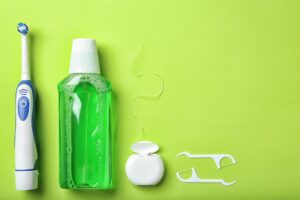August 4th, 2022

Educating our patients on healthy dental routines is very important to us. With National Fresh Breath Day coming up in a few days, we wanted to share some important dental health information with everyone!
No matter what, you should be brushing your teeth every day. But don’t just stop there, make sure you are flossing and brushing your tongue as well. These are all important habits to build to ensure fresh breath. Maintaining a good oral hygiene routine will help kill the bacteria that cause bad breath.
We do recommend rinsing with mouthwash after brushing. Mouthwashes don’t replace brushing and flossing but it can be a helpful addition to the routine. Fluoride rinses can be used after brushing to help strengthen your teeth and prevent decay and decalcification of your teeth.
For all of our patients in school, brushing after lunch would be ideal. You can also carry a travel toothbrush and floss with you, which can be helpful if you have a chance to use them. At the very least, rinse with water after eating snacks or lunch.
To ensure that your visits continue to be easy follow our steps: brush and floss daily, rinse whenever you have a chance, and minimize sweet and acidic foods. By maintaining these good habits, you’ll have a happy and healthy smile!
August 3rd, 2022

Now that many of the schools in Andover are back in session, Dr. Kathleen Chan and Dr. Ivy Chen would like to remind all of our patients about the importance of scheduling appointments in advance. With school, clubs, sports, and family duties to consider, we know that it can be challenging to find time to visit Chan & Chen Orthodontics this fall. In order to accommodate all of our patients’ busy schedules, it is important that you plan ahead for your appointments so that we are able to provide you with a convenient appointment time.
As always, please remember to give us advanced notice if you’re unable to make your regularly scheduled appointment with Dr. Kathleen Chan and Dr. Ivy Chen and our team. Feel free to give us a call if you have any questions, or if you would like to schedule your fall appointment.
We’ll see you soon and hope summer is winding down nicely for you and your family!
July 27th, 2022

Kids can be picky eaters. How many times have you seen your child try to hide the peas under a mound of mashed potatoes?
At Chan & Chen Orthodontics, Dr. Kathleen Chan and Dr. Ivy Chen and our team understand how hard it can be to get your child to eat the recommended daily allowance of fruits and vegetables. The task of providing fun, nutritious meals becomes even more challenging if he or she wears braces. It's an age-old saying that breakfast is the most important meal of the day. These five braces-friendly recipes are not only nutritious, but they will have little Jimmy flashing his “tin grin” when he sits down at the kitchen table in the morning.
- Scrambled eggs are soft and easy to eat if you have braces. If you drown them in ketchup (which many kids love to do), eggs become even mushier. Minimal chewing is required, and that’s the key to a braces-friendly recipe.
- A healthy breakfast provides energy and jump-starts metabolism. A smoothie is not only a good source of fruit, but it’s also gentle on braces. More importantly, smoothies are fun to create. You can toss anything in the blender (bananas, mangoes, strawberries, spinach) and create a drink that’s loaded with vitamins and antioxidants.
- If you wear braces, eating crunchy cereals or granola for breakfast is out of the question: Bite down the wrong way and you might snap the wires or dislodge the brackets. However, you can get your grains and oats by substituting oatmeal for cereal. This mushy breakfast treat has a host of health benefits.
- Pancakes are not the healthiest breakfast choice. Still, this Sunday morning favorite is braces-friendly. The idea is to make it healthier by hiding blueberries in the pancake batter just like your child hides peas in the mashed potatoes.
- Toast with jam is ok, but skip slathering peanut butter on the bread. If you have braces, the general rule of thumb is to steer clear of foods that are hard or chewy. These types of foods can break wires. Of course, most kids will agree that toast isn’t the most exciting breakfast recipe. Make it a Pop-Tart instead!
For more braces-friendly recipes, please give us a call at our convenient Andover office!
July 20th, 2022

At Chan & Chen Orthodontics, there are a few things we want to remind you of when you're on vacation, so that a day with friends and family won’t be spent dealing with an orthodontic emergency. Firstly, we are here for you whether you are in town or out of town on vacation. Give us a call and we may be able to address the problem over the phone. Second, if we are unable to help you fix the problem over the phone, we will help you find an orthodontic practice in your vacation area that can help you.
If you experience problems reaching our office, we suggest going online and searching for orthodontic practices in your area. Most orthodontists will lend a helping hand to another orthodontic patient and get them out of pain or discomfort.
If you have braces, whether they are metal, ceramic, or lingual, Dr. Kathleen Chan and Dr. Ivy Chen and our team suggest steering clear of the following foods to avoid broken brackets and/or wire distortion while you are on vacation:
- Chewy, sticky, or gummy food
- Apples, pears and other whole fruits (cut fruit into thin wedges before consuming)
- Bagels and hard rolls
- Bubble gum
- Corn on the cob
- Hard candies
- Hard cookies
- Pretzels
- All varieties of nuts, including peanuts, almonds, and cashews
Finally, if you have clear aligners and you lose your tray, don’t worry! Simply put in either the previous tray or the next tray and contact us as soon as you get home!
Follow these tips and you can have a worry-free vacation!





 Website Powered by Sesame 24-7™
Website Powered by Sesame 24-7™